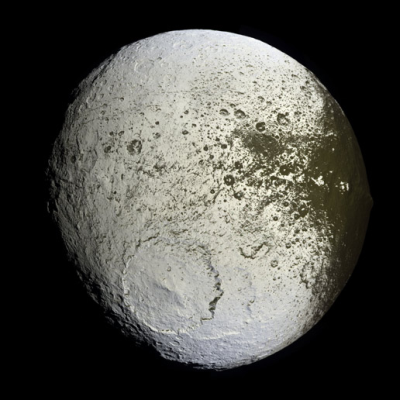10 October 2007

Credit: NASA/JPL/Space Science Institute
NASA recently published a breathtaking image of Saturn's enigmatic moon Iapetus. This is the first high-resolution image of the moon's bright trailing hemisphere.
Iapetus (1,468 km across), Saturn's third largest moon, is characterized by the drastic two-toned coloration, resembling the yin-yang symbol of Far Eastern thought. Also, Iapetus has a giant equatorial ridge that makes the moon similar in appearance to a walnut.
Like our Moon, Iapetus keeps one hemisphere turned to its parent planet. Thus, as Iapetus orbits Saturn, one hemisphere is always leading, and the other is trailing. Iapetus' leading hemisphere is dark as coal, while the trailing hemisphere is as bright as snow.
Iapetus was discovered by Giovanni Cassini (1625-1712), who was able to observe Iapetus only when it is on the western side of Saturn. Cassini concluded correctly that Iapetus has a dark hemisphere and a bright hemisphere, and the moon's rotation is locked to its planet. The dark hemisphere of Iapetus, visible from Earth when the moon is on the eastern side of Saturn, was too faint to be detected by the feeble 17th century telescopes.
The above image is a false color mosaic of the entire hemisphere of Iapetus, visible from Cassini during the spacecraft's recent close encounter with the moon in September 2007.
Interestingly, the image shows the complicated transition region between the dark leading and bright trailing hemispheres. This region, on the right of image, was observed in many images acquired by Cassini near its closest approach to Iapetus during the flyby.
The geologic features that characterize the trailing hemisphere are revealed in this image for the first time. The region is densely cratered, particularly in the north and south polar regions. Numerous impact features are visible near the top of the mosaic. These terrains were also recorded in Voyager 2 spacecraft images in 1981.
The most striking surface feature is the giant 450-km wide impact crater, in the bottom of image. It overlaps an older, similar-sized impact basin to its southeast.
The origin of the coloration of Iapetus remains unknown. Probably it is the result of volcanic activity or debris splattered from another object.
In many places, the dark material, thought to be composed of nitrogen-bearing organic compounds known as cyanides, hydrated minerals and other carbonaceous minerals, appears to coat equator-facing slopes and crater floors. The distribution of this material and variations in the color of the bright material across the trailing hemisphere will be crucial clues to understanding the origin of Iapetus' bizarre double-faced appearance.
The view was acquired with the Cassini spacecraft narrow-angle camera on 10 September 2007, at a distance of about 73,000 km from Iapetus.
The image is color-enhanced and shows an expansion of the wavelengths of the electromagnetic spectrum visible to human eyes. The intense reddish-brown hue of the dark material is much less pronounced in true color images.
This mosaic consists of 60 images covering 15 footprints across the surface of Iapetus. The view is an orthographic projection, resembling the view observed by a distant observer looking at Iapetus through a telescope.
At each footprint, a full resolution clear filter image was combined with half-resolution images taken with infrared, green and ultraviolet spectral filters (centered at 752, 568 and 338 nanometers, respectively) to produce this full-resolution false color mosaic.
Further Reading
Cassini-Huygens Mission to Saturn
http://saturn.jpl.nasa.gov/
Aymen Mohamed Ibrahem
Senior Astronomy Specialist